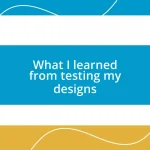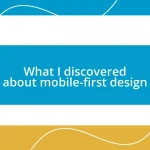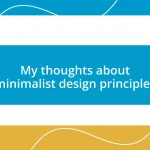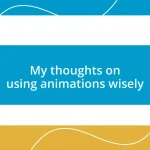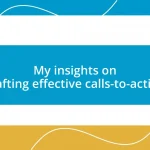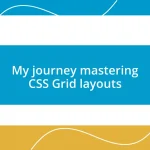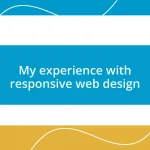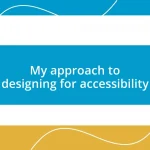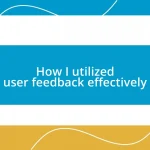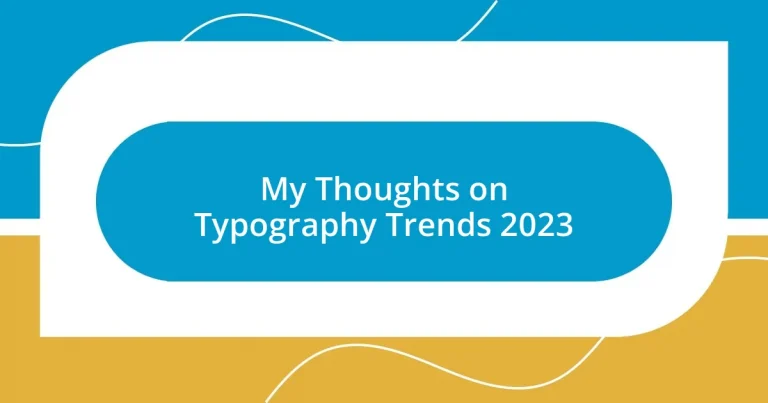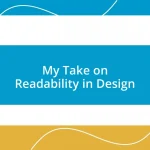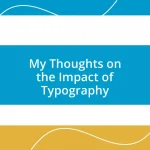Key takeaways:
- Typography conveys emotions and messages, influencing viewer perception and engagement.
- Key trends for 2023 include bold and oversized fonts, mixed styles, and the use of warm color palettes.
- Effective typography enhances user experience, brand identity, and storytelling in various applications.
- Future trends suggest more integration of typography into branding and adaptive designs to improve accessibility.
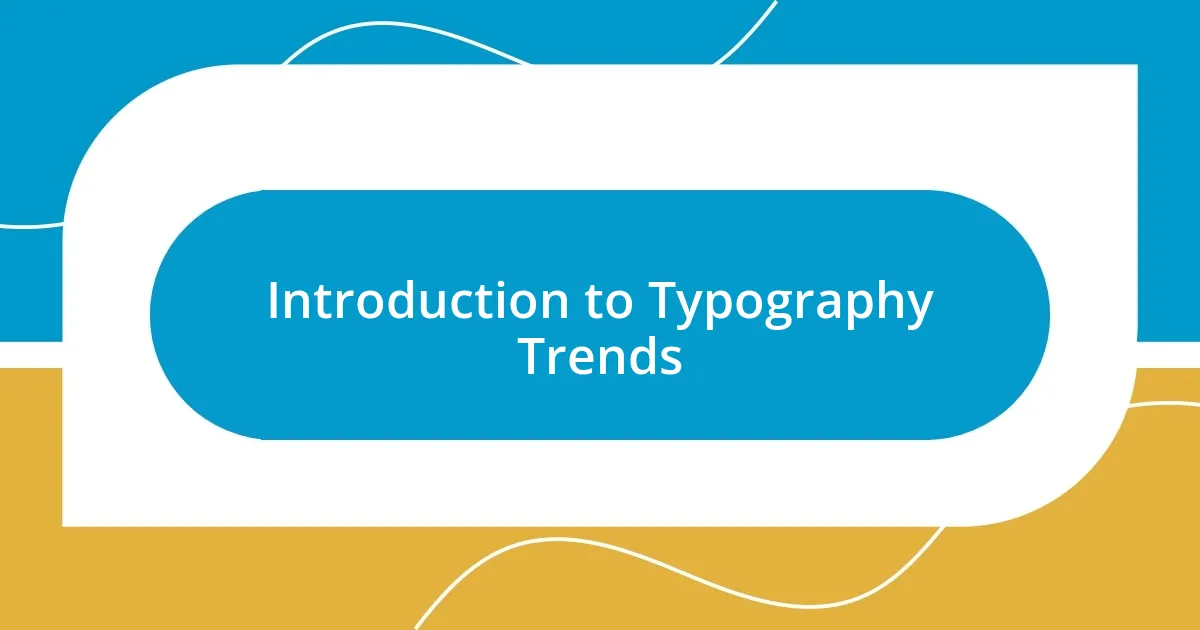
Introduction to Typography Trends
Typography trends are constantly evolving, reflecting cultural shifts, technological advancements, and aesthetic preferences. As I observe these changes, I can’t help but feel that typography is not just a design choice—it conveys emotions and messages that words alone sometimes fail to deliver. Have you ever noticed how a particular font can evoke nostalgia or urgency? It’s fascinating how subtle adjustments in type can dramatically alter a piece’s overall impact.
This year, I’m particularly excited about the resurgence of bold, experimental fonts. It’s as if designers are bravely stepping out of their comfort zones, allowing themselves to play with shapes and sizes in ways we haven’t seen in years. Personally, this trend inspires me to think creatively; every time I come across an inventive typeface, I’m reminded of the limitless potential within design.
Moreover, the blending of classic and contemporary styles feels like a conversation between past and present. I love how designers experiment with modern technology while paying homage to traditional craftsmanship. This fusion brings a refreshing depth to typography, making it not only a tool for communication but also a form of artistic expression. What do you think about the balance of innovation and tradition in design? I find it to be a beautiful dance that keeps our visual language alive and vibrant.
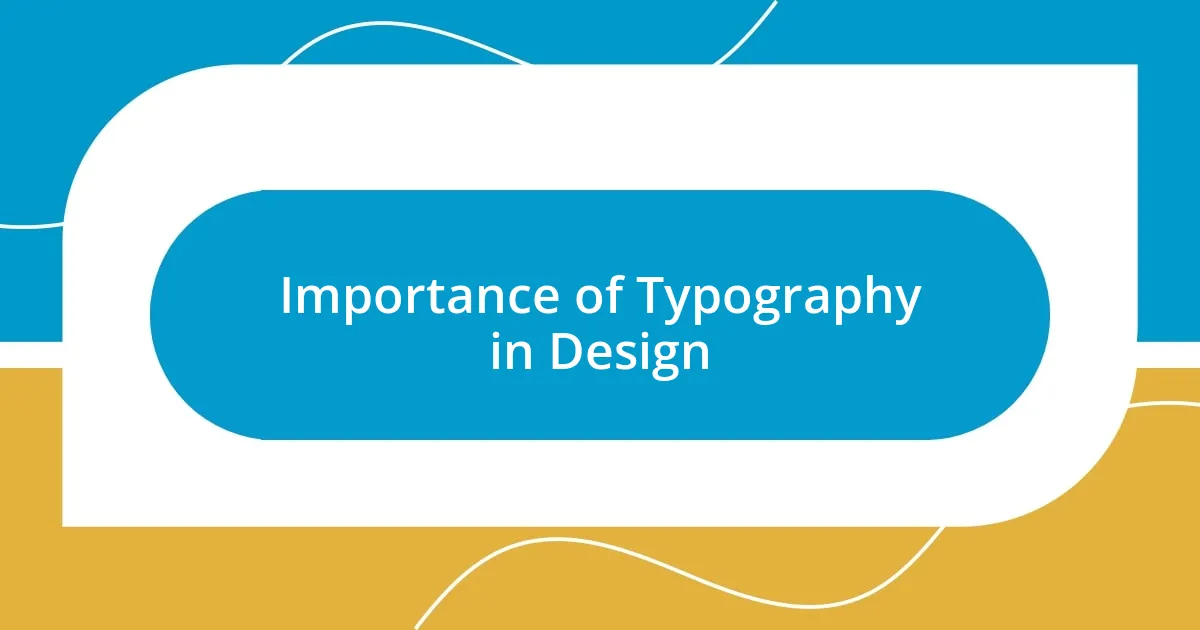
Importance of Typography in Design
Typography plays a crucial role in design, acting as the voice of a visual communication piece. I’ve often found that the right font can set the tone before the viewer even reads a single word. For instance, when I designed a flyer for a local art event, I chose a whimsical font that matched the playful spirit of the occasion. The feedback was overwhelmingly positive, and I truly believe that the typography contributed to the overall success of the invitation.
In the world of branding, typography can be as influential as color or imagery. I remember when I rebranded my personal project; the moment I switched to a sleek sans-serif font, the entire aesthetic transformed. It became more modern and approachable, instantly aligning with my target audience’s expectations. Typography is not just about legibility; it’s also about creating an emotional connection that resonates with viewers.
Lastly, the evolution of typography reflects broader design trends. Currently, minimalism prevails, emphasizing clarity and efficiency. From my perspective, a clean typeface can enhance a website’s user experience significantly. I recently revamped my portfolio site using a simple, elegant font. The result was not just visually appealing but also made it easier for visitors to navigate. Typography is essential because it shapes how we interpret and interact with design—wouldn’t you agree?
| Aspect | Significance |
|---|---|
| Emotional Impact | Sets the mood and tone before reading begins. |
| Brand Identity | Communicates values and personality, helping brands stand out. |
| User Experience | Affects legibility and navigation, influencing how audiences engage. |
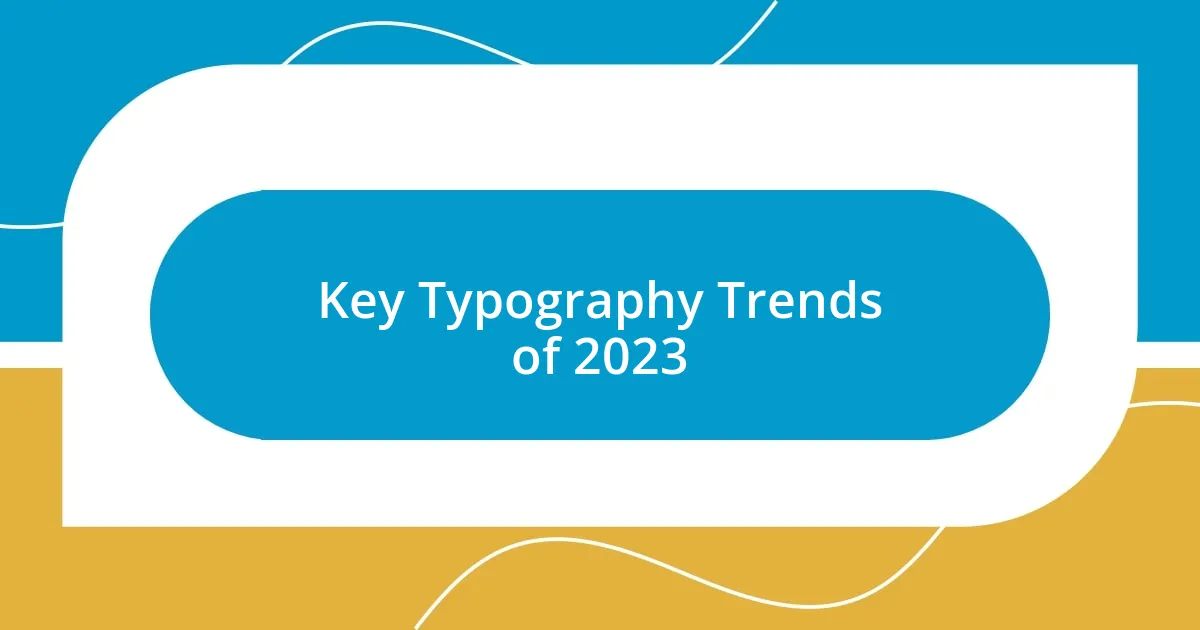
Key Typography Trends of 2023
One trend that has captured my attention this year is the rise of oversized typography. It’s quite a bold statement, isn’t it? I remember creating a poster for a community event where I used a gigantic typeface as the focal point. The result was eye-catching—people couldn’t help but stop and read it! This trend not only elevates the importance of the message but also allows for creativity in layout, making the entire design feel more dynamic.
Here are some of the key typography trends I’ve observed for 2023:
- Bold and Oversized Fonts: These fonts draw attention and create urgency, demanding viewers to engage.
- Mixed Typographic Styles: Combining serif and sans-serif fonts fosters a playful contrast that can invigorate a design.
- Handwritten and Authenticty-Driven Typefaces: These evoke a personal touch, making brands feel more relatable and human.
The use of warm, vibrant colors in typography is another exciting trend I’m seeing this year. I’ve recently experimented with a palette that includes rich yellows and deep blues in my work. The warmth of the colors paired with the type style creates a welcoming atmosphere—perfect for connecting with viewers on a personal level. I find myself drawn to designs that not only inform but also resonate emotionally, and color plays a huge role in that connection.
- Warm Color Palettes: Utilize colors that evoke emotion and friendliness, inviting viewers to feel engaged.
- Variable Fonts: These adaptable typefaces allow designers to refine style based on context, creating versatile applications.
- Minimalistic Elegance: Simple designs with thoughtful typography speak volumes without overwhelming the viewer.
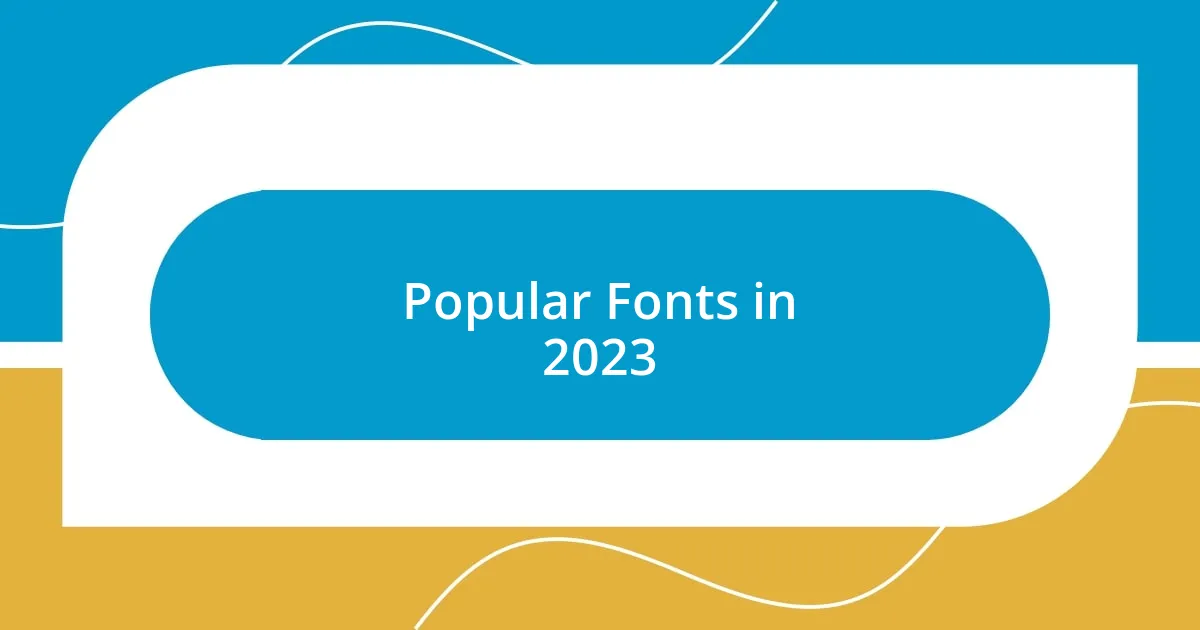
Popular Fonts in 2023
This year, I’ve noticed a growing popularity of vintage-inspired typefaces that evoke nostalgia. When I experimented with a classic serif font for a branding project, the response was overwhelmingly positive. It struck a chord with my audience, connecting them to something familiar and heartwarming. Don’t you think that nostalgia can sometimes be a powerful tool in design?
Another fascinating trend is the emergence of variable fonts, which I find incredibly versatile. They allow me to adjust weights and styles on the fly, ensuring the typography perfectly matches the mood and message. For instance, while creating a promo for a local coffee shop, I played with the font’s weight, shifting from light and airy for morning specials to bold and energetic for evening events. It was like having a chameleon at my disposal – how cool is that?
Lastly, I can’t help but mention the increasing use of custom and hand-drawn fonts. I once collaborated with a local artist who created a unique font that encapsulated their personality and artistic flair. When we used it on their website and promotional materials, it not only grabbed attention but also forged a deeper connection with their audience. I often think about how these personal touches can truly set a brand apart—wouldn’t you agree?
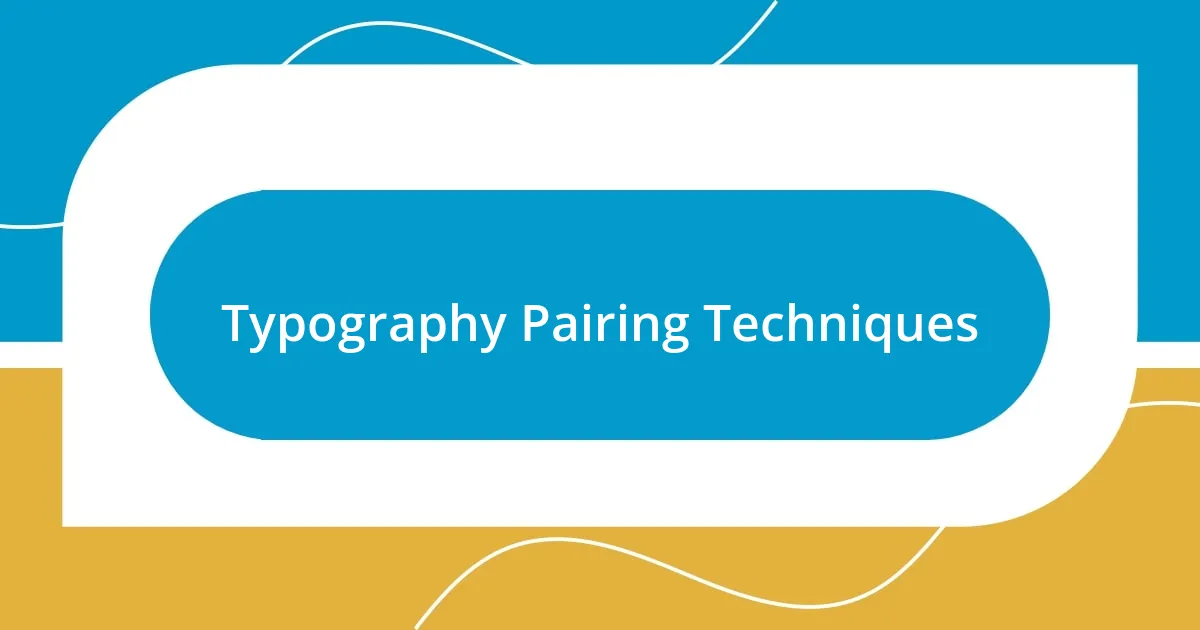
Typography Pairing Techniques
When it comes to typography pairing techniques, I find that contrasting fonts can create a dynamic visual dialogue. I remember working on a flyer where I combined a sleek sans-serif headline with a classic serif body text. The contrast not only made the main message pop but also drew the reader’s eye smoothly across the page—something in that harmony felt just right. Isn’t it fascinating how a simple choice can elevate the entire design?
Another effective technique is using scale to create hierarchy. In a recent project, I utilized larger, bold typography for headings alongside smaller, lighter fonts for subheadings. This not only guided the reader’s focus but also established a clear path through the content. Have you ever noticed how your eye naturally gravitates towards larger text? It’s a strategy that, when executed well, can make information more digestible.
Don’t overlook the power of color in typography pairing too. I tried pairing two fonts—one a vibrant display typeface and the other a muted classic—with a carefully chosen color palette. The bold text commanded attention while the softer type provided balance, making the overall design feel cohesive yet exciting. How do you think color influences your reading experience? In my experience, it can make all the difference between a design that merely informs and one that truly engages.
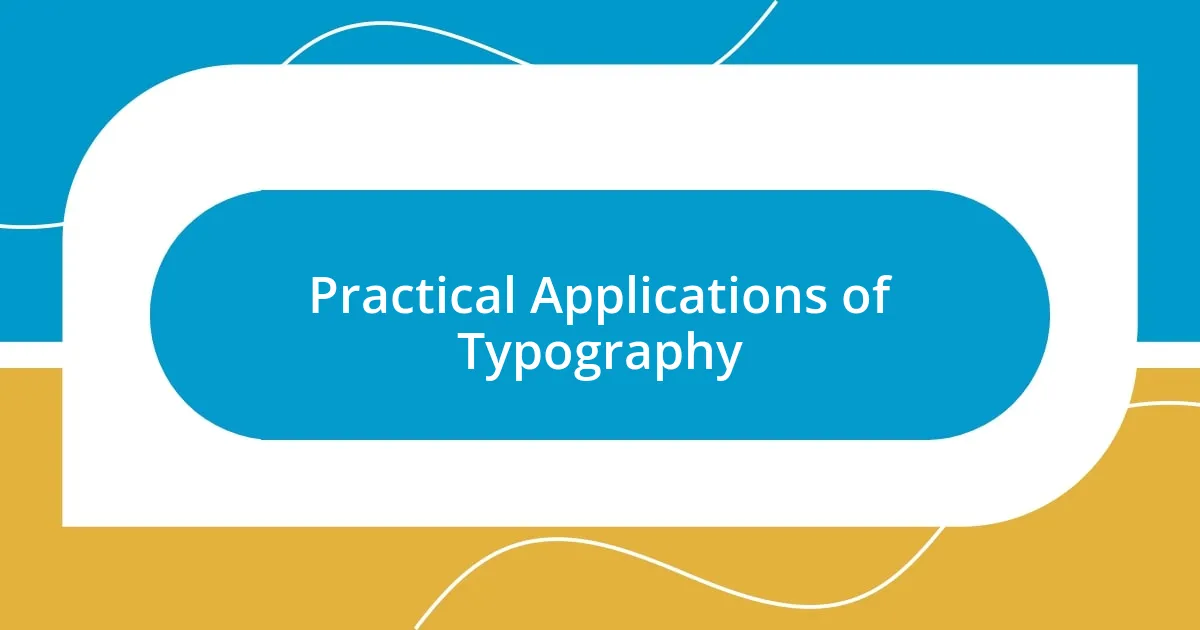
Practical Applications of Typography
One of the most exciting practical applications of typography I’ve experienced recently is integrating it into websites for better user engagement. During a project for an online boutique, I chose a clean, modern sans-serif font for the navigation to ensure clarity and ease of use. The result? A noticeable increase in time spent on the site, which made me wonder how something as seemingly simple as font choice can truly affect user behavior. Have you ever clicked away from a site simply because the text was hard to read?
Typography also plays a critical role in marketing materials, where the right font can amplify the intended message. For instance, while designing a poster for a charity event, I selected a warm, approachable typeface that exuded friendliness and compassion. The feedback I received was heartwarming; people felt an instant connection to the cause, highlighting just how vital typography is in evoking emotions. Isn’t it intriguing how a few letters can translate into feelings of warmth and urgency?
Moreover, I’ve found that typography can greatly enhance storytelling in presentations. When I recently crafted a slide deck for a client’s pitch, I integrated a bold, attention-grabbing font for key messages and a softer serif for the narrative portions. This not only helped to emphasize crucial points but also guided the audience through the story seamlessly. How often do you think typography influences a speaker’s effectiveness? From my perspective, it transforms the experience from a simple presentation into a compelling narrative that captures the audience’s attention.
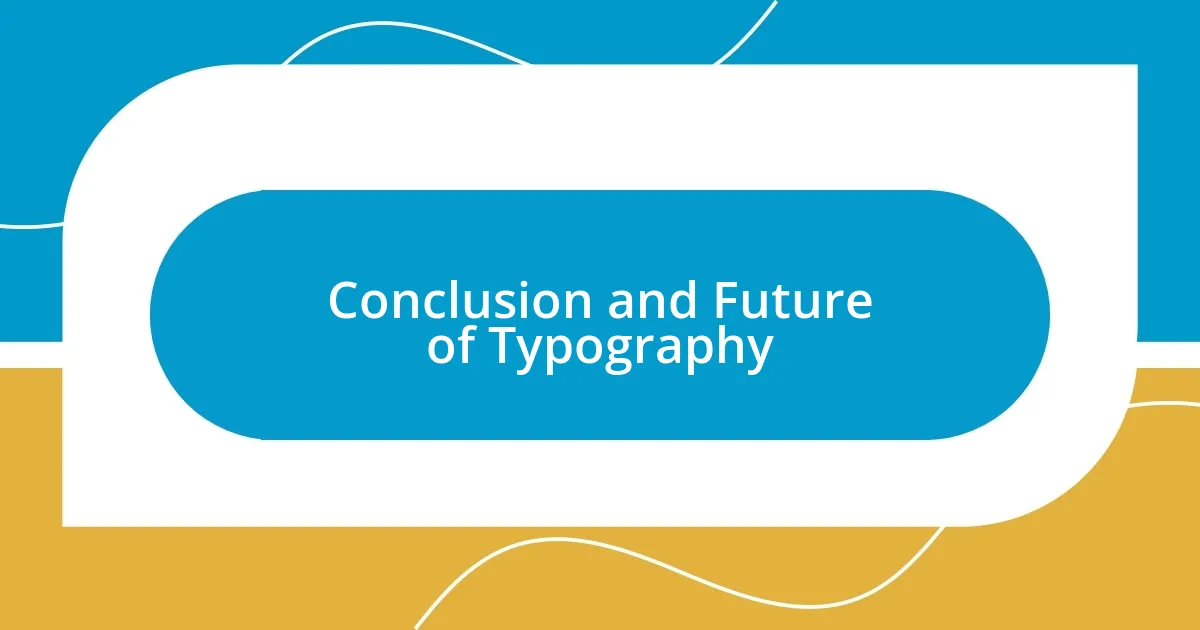
Conclusion and Future of Typography
As I reflect on the trajectory of typography, it’s clear that it’s never been merely about aesthetics—it encapsulates a deeper narrative. I recently attended a workshop where the conversation centered on the emotional weight of typography. I was struck by how different font styles can evoke specific feelings; it made me realize that selecting the right typeface is like choosing the right voice to convey a message. Isn’t it amazing how something we often overlook can shape our perception in profound ways?
Looking ahead, I believe we’re moving towards even greater experimentation with typography, particularly as technology advances. I’ve experimented with variable fonts that adapt fluidly based on screen size, which spoke volumes in my recent designs. This adaptability not only provides a fresh look but also addresses accessibility, ensuring everyone can engage with the content effortlessly. Have you begun to notice how typography varies across different platforms? It’s exhilarating to think about the possibilities we’re paving for future designs.
In the future, I envision typography becoming increasingly integrated with branding and identity. Recently, I worked on a project where we developed a unique typeface that encapsulated a brand’s essence, and it was transformative. The way that typography can capture a company’s voice is a unique selling proposition that can set a brand apart. How do you think the right typography influences brand perception? My experience has taught me that when brands invest in thoughtful typographic choices, they communicate their values, which can truly resonate with their audience.

